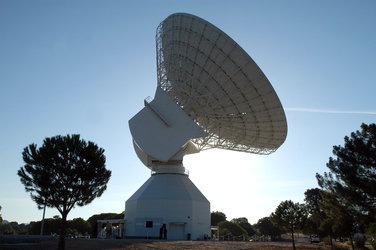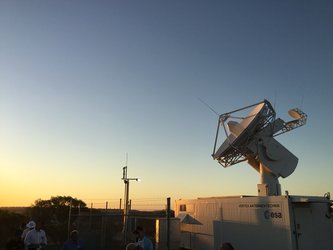Accept all cookies Accept only essential cookies See our Cookie Notice

About ESA
The European Space Agency (ESA) is Europe’s gateway to space. Its mission is to shape the development of Europe’s space capability and ensure that investment in space continues to deliver benefits to the citizens of Europe and the world.
Highlights
ESA - United space in Europe
This is ESA ESA facts Member States & Cooperating States Funding Director General Top management For Member State Delegations European vision European Space Policy ESA & EU Space Councils Responsibility & Sustainability Annual Report Calendar of meetings Corporate newsEstablishments & sites
ESA Headquarters ESA ESTEC ESA ESOC ESA ESRIN ESA EAC ESA ESAC Europe's Spaceport ESA ESEC ESA ECSAT Brussels Office Washington OfficeWorking with ESA
Business with ESA ESA Commercialisation Gateway Law at ESA Careers Cyber resilience at ESA IT at ESA Newsroom Partnerships Merchandising Licence Education Open Space Innovation Platform Integrity and Reporting Administrative Tribunal Health and SafetyMore about ESA
History ESA Historical Archives Exhibitions Publications Art & Culture ESA Merchandise Kids Diversity ESA Brand CentreLatest
Space in Member States
Find out more about space activities in our 23 Member States, and understand how ESA works together with their national agencies, institutions and organisations.
Science & Exploration
Exploring our Solar System and unlocking the secrets of the Universe
Go to topicAstronauts
Missions
Juice Euclid Webb Solar Orbiter BepiColombo Gaia ExoMars Cheops Exoplanet missions More missionsActivities
International Space Station Orion service module Gateway Concordia Caves & Pangaea BenefitsLatest
Space Safety
Protecting life and infrastructure on Earth and in orbit
Go to topicAsteroids
Asteroids and Planetary Defence Asteroid danger explained Flyeye telescope: asteroid detection Hera mission: asteroid deflection Near-Earth Object Coordination CentreSpace junk
About space debris Space debris by the numbers Space Environment Report In space refuelling, refurbishing and removingSafety from space
Clean Space ecodesign Zero Debris Technologies Space for Earth Supporting Sustainable DevelopmentLatest
Applications
Using space to benefit citizens and meet future challenges on Earth
Go to topicObserving the Earth
Observing the Earth Future EO Copernicus Meteorology Space for our climate Satellite missionsCommercialisation
ESA Commercialisation Gateway Open Space Innovation Platform Business Incubation ESA Space SolutionsLatest
Enabling & Support
Making space accessible and developing the technologies for the future
Go to topicBuilding missions
Space Engineering and Technology Test centre Laboratories Concurrent Design Facility Preparing for the future Shaping the Future Discovery and Preparation Advanced Concepts TeamSpace transportation
Space Transportation Ariane Vega Space Rider Future space transportation Boost! Europe's Spaceport Launches from Europe's Spaceport from 2012Latest

Radio telescopes hear last signal from SMART-1
Thank you for liking
You have already liked this page, you can only like it once!
This short animation shows the SMART-1 carrier radio signal in the last moments of the spacecraft's life, as detected by the Australia Telescope Compact Array (CSIRO) radio station on 3 September 2006.
The signal stopped at 07:42 CEST (05:42 UT), when the spacecraft hit the Moon. Other radio telescopes involved in tracking the probe - the German-Chilean TIGO (BKG) 6-metre antenna in Chile and the Mount Pleasant Observatory of the University of Tasmania (Australia) - also heard SMART-1's final signal. The Medicina (INAF) 32-metre antenna in Italy and the Fortaleza (ROEN) 14-metre antenna in Brazil were not in view of the spacecraft at the time of impact, but complemented the observations during the last orbit.
Starting in spring 2006, these radio measurements provided extremely precise tracking of SMART-1.
The animation shown here presents a time resolution of 5 seconds (i.e. the signal is presented every five seconds). However the radio observations were done with a very high accuracy, on a millionth-of-a-second time resolution. This time span corresponds to a 2-centimetre motion of the spacecraft.
The signal shown in the animation (the peaks) is the result of the interference between a radio signal received directly from SMART-1 and its reflection from the Moon's surface.
In parallel to these radio observations, the Radio Science Receiver of the SMART-1 KaTE/Ka-band experiment received on Earth the last signal from the spacecraft at 07:42:25 CEST (05:42:25 UT), through the NASA Deep Space Network radio station 'DSS13' in the California Desert.
-
CREDIT
JIVE (NL), ATNF (Australia), Univ. of Tasmania (Australia), TIGO (DE/Chile) -
LICENCE
ESA Standard Licence

SMART-1 impact flash seen by CFHT telescope

Deep space radio antenna in Cebreros

NNO2

SMART-1’s view of a waning Earth















 Germany
Germany
 Austria
Austria
 Belgium
Belgium
 Denmark
Denmark
 Spain
Spain
 Estonia
Estonia
 Finland
Finland
 France
France
 Greece
Greece
 Hungary
Hungary
 Ireland
Ireland
 Italy
Italy
 Luxembourg
Luxembourg
 Norway
Norway
 The Netherlands
The Netherlands
 Poland
Poland
 Portugal
Portugal
 Czechia
Czechia
 Romania
Romania
 United Kingdom
United Kingdom
 Slovenia
Slovenia
 Sweden
Sweden
 Switzerland
Switzerland
























